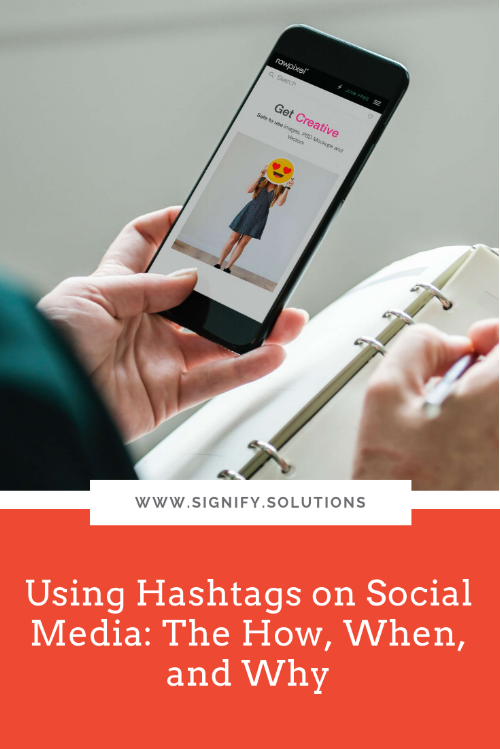Today’s post comes from my friend, Jennifer Wilder. Jen is a social media marketing pro, and a constant source of information and inspiration. She’s the first person I turn to when I have questions, and she even set me up on Smarterqueue last year, so that most of social media is automated.
Using hashtags is something I frequently talk to people about when they’re working on their social media strategy. Too many cause-focused organizations seem to leave them off completely, but they can be a great tool for helping new people find you. Otherwise, those already in your tribe will be the only ones to see your post . . . and still only a percentage of them. (Thanks, algorithms!)
So, do yourself a favor and read up on why hashtags should be a part of your social media strategy. This post is #allthethings when it comes to using hashtags, so be sure to bookmark it for referencing again later!
Are hashtags a part of your social media strategy? Do you even know what a hashtag is? Hashtags are a means of finding conversations in social media around desired topics. They are keywords preceded by the hash (#) or pound mark. Within social media platforms, hashtags are clickable, so that you can find all posts that include the hashtag on which you clicked.
These small indicators within your social posts can start conversations, attract customers or donors, and change public sentiment. Are they powerful tools? When used strategically, you better believe it.
The Power of Hashtags
We’ve all seen that picture of someone holding up a coffee cup in front of a clear blue sky accompanied by hashtags like: #love #coffee or even #instagram. How effective do you think those hashtags are in helping someone get discovered on social media? Here’s a hint: not at all. But there are hashtags that could be used with that picture that would drive engagement and possibly attract customers or donors.
When we think of hashtag strategy, we most commonly think of Twitter and Instagram. Recently, though, LinkedIn increased their promotion of hashtag use on their platform by allowing users to search and follow hashtags through a feature called “Your Communities.” In addition, you can pin hashtags so that posts within that topic appear first in your LinkedIn feed. When searching hashtags, there is also a new discover feature that shows how many people are following that hashtag, as well as various features to dive deeper into insights surrounding searched hashtags.
Another platform that is now embracing and promoting hashtag use is Pinterest, where up to 20 hashtags are allowed per pin.
Though the capability for using hashtags exists on Facebook, they are not recommended unless you are posting from an event with only the event hashtag so that the event organizers can find you and possibly reuse your post—taking into consideration that you must change your privacy settings to public for those specific posts.
The space in your social media posts is precious, so let’s use that space to find customers and donors. Here’s what you need to know about hashtags to enhance your posts, as well as search out potential supporters.
How to Find Hashtags for Your Business
Create a list of keywords (or common words) associated with your organization and mission—these are the things that you want to be known for. Some examples include nonprofit, social enterprise, modern slavery, homelessness, or social impact. It’s likely those keywords are already being used as hashtags, so give them a search on Twitter or Instagram. You’ll want to scroll through each hashtag to determine if the conversation around each keyword is a conversation you want to enter.
Hashtags should not include spaces or punctuation. If you wish, you can camel capitalize—capitalizing the first letter of each word—a hashtag for easier reading, like this: #ThisIsCamelCaps
As you search keywords as hashtags, look to see what other hashtags people are using. Perhaps some of the keywords they’re using would better resonate with your potential customers, or should also be used by your organization.
Search for other people or other organizations that are like yours, in your industry, or that are the type of organization you want to become. Read through their social posts to find hashtags not already on your list.
Once you have a large list of hashtags, you’ll want to know a little bit about each. Search each hashtag on the respective platform noting how many posts are using that hashtag, and noting the types of images that are most popular. You will also want to pay attention to context. Does the hashtag mean what you think it means on the Internet? It might not.
When using hashtags for Instagram, be sure to use a variety of counts. Meaning, use a few hashtags that have 250,000 to 350,000 posts; use a few that have 100,000 to 250,000; use a few that have 50,000 to 100,000, and a few that are less than 50,000.
Broad subject keywords with 350,000+ posts are not going to get you seen by potential customers or donors. With that number of posts on a hashtag, the posts are coming so fast that your post will constantly be pushed down the feed, getting very little eyeballs on it. That’s why it’s best to use a variety of post counts on each hashtag, not using those over about 350,000. An example would be #event, which is extremely general and won’t help you gain any traction.
If you have a storefront, or if you are serving a particular region of the country, then you want to be sure to include hashtags that are location specific.
If you want to work with or get noticed by particular brands or organizations, use their personal hashtags. Many times organizations create their own that they use often within their social media, which you can likely find by viewing their Twitter or Instagram accounts. Since hashtags can’t be owned or sponsored by any company, you are free to use their hashtags to get their attention, or to align yourself with their message. Use this tactic mindfully—hitting their hashtag too often with irrelevant content is off-putting. A popular example of this is #EndItMovement, which is used by not only the End It Movement itself, but partners and people who are trying to raise the awareness of modern-day slavery.
If you choose to use the maximum number of hashtags allowed on Instagram—which is 30!—sprinkle in a few hashtags that are funny, or that share additional funny commentary about the image you’re posting. Going back to the picture of the coffee cup that I referenced, you could add the hashtag, #NeedISayMore, to show off your brand’s personality.
Using all 30 hashtags on Instagram may seem excessive if this is a new process to you, but you’re already doing the work of posting, so why not use the opportunity to be seen by more people?
Once you have a list of hashtags you want to use, you can rotate through them with each post. If you prefer, you could create a different, or customized, batch of hashtags for each day of the week that you’re posting. Use the notes feature on your smartphone to keep track of your hashtag list. Then copy/paste into the first comment on Instagram.
How to Use Hashtags in Your Social Media Posts
On Twitter, LinkedIn and Pinterest, it’s more acceptable to use hashtags within the body of the post more so than it is on Instagram.
Just be sure to pay attention to hashtag limits on each platform.
For Instagram, 30 hashtags can be used for posts appearing in your feed.
For Twitter, there’s only a limit to how many characters you can tweet, which is now 280. However, a maximum of three hashtags is recommended, and can be used in the body of the copy or added to the end of the copy.
For Pinterest, 20 hashtags are allowed for each pin, though 10 is considered optimal. Frequent users of Pinterest use three to five per post.
For LinkedIn, there is no limit to the number of hashtags that can be used, but pay attention to relevance and aesthetic. You don’t want to make your reader weary with a large amount of hashtags. And please note: While editing articles is allowed on LinkedIn, editing or removing hashtags within a published article is not allowed.
For Instagram Stories, there is a hashtag sticker that will accommodate one hashtag. Additional hashtags can be added as a text block. You can then reduce that text block down by pinching together your fingers until it is barely seen. Or you can color the block of hashtag copy as the same color as your background using the eyedropper tool in the bottom left while within the editing block of the hashtag copy. Or, you can reduce the hashtag block and hide it behind a block of copy that you do want people to read. This would be done so that the hashtags don’t distract from the photo, video, or other content you’re highlighting in the Story.
Additionally, it’s common practice on Instagram to add hashtags in the first comment. The reason many people do this is to keep their captions looking neat and tidy. Another option is to use one dot on a line for five lines in order to push the hashtags down, either far away from the caption if they add them there, or to push them down from being seen in the first comment.
This can make for a cleaner, neater post on Instagram. However, if you’re going to use the one-dot-per-line method of paragraph breaks on Instagram, you can create your post content in the notes feature on your smartphone, and then copy/paste to Instagram since there isn’t a paragraph break button on that platform, or hit the period key and then enter repeatedly to manually create breaks.
When using an event hashtag on Facebook, be sure your posts are set to “public” so that event organizers can view your posts and possibly reuse them on their brand’s social accounts.
How to Use Hashtags to Create Connections and Find Potential Customers and Donors
From your master list of hashtags, choose one to search and scroll through. As you find posts and images that interest you, leave a genuine comment on that post—preferably 8-10 words.
Be sure your comment adds value to the post. This means you shouldn’t just drop a heart emoji or say “Nice job!” It’s unlikely anyone will check out your account or interact much with you without any effort on your part. And for bonus points, ask a question in order to start a conversation.
Because Pinterest is a discovery/search engine (they do not consider themselves a social platform), engagement on pins is not weighted the same way as it is on Twitter, Instagram, or LinkedIn. Meaning, it’s unlikely to produce a lot of results. Pinterest isn’t a place you go to in order to interact with people and have conversations.
Next, if you find a post within a hashtag search that is getting good engagement with many comments, dig deeper into who is leaving those comments. Click the username of the person or business leaving the comment, go to their account, find a picture within the last three or four posted to their account and leave them a genuine comment.
Likewise, you can go to the account of a similar organization to your own, find a recent post with good engagement (multiple comments), and click through to the accounts of people leaving comments on their post. Then, leave a genuine comment on one of their recent posts.
What you’re doing in all of these instances is connecting with people, nonprofits, and social enterprises who have liked something similar to your own business—so why wouldn’t they want to follow you too and eventually buy from you?
Helpful Tools
If you’re still struggling to come up with the right hashtags for your brand, or simply need more options, check out Hashtagify.me. This site allows you to type in a keyword search term, and give you related options that people are already using.
Additionally, if you’re looking to add some oomph to your Instagram strategy, I recommend PeopleMap, which lets you track influencers, create lists, evaluate campaign engagement, and more.
Finally, posting on Instagram can definitely eat away at the time in your day. If that’s an issue for you, consider trying out a social media scheduler like Hootsuite, Later, Planoly, Smarterqueue, or any number of other options.
For what some may think of as a throw-away or a random portion of a social media post, the hashtag can be quite powerful when content creators take the time to be intentional and strategic.
Now that you have this power, what good are you going to do with it?
Jennifer Wilder is one smart cookie. If you like this post, you might like one of the previous guest posts she’s written for Signify:
Jennifer Wilder is a social media professional who helps brands reach customers through online conversations. Over the last decade, she has worked with LifeWay Christian Resources, Leading The Way, The reThink Group/Orange, and The John Maxwell Company. Jen and her husband Nathan live in Kennesaw, Georgia, with their soon-to-be-Instagram-famous Chocolate Labrador Retriever, Copper.
Jennifer is available for freelance social media consulting and voiceover work.
PIN THIS POST FOR LATER:
I'm Kristi Porter, and I started Signify to provide writing and consulting services to nonprofits and for-profit organizations with a social mission, primarily through copywriting, marketing, and business communications. I also teach solopreneurs and small businesses how to incorporate philanthropy and giving strategies. I believe that cause-focused organizations are the future of business. You're proof that companies can both make money and do good. And I'm here to help you get noticed and grow. When you succeed, we all win.







































